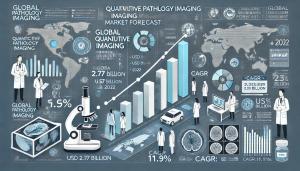Quantitative Pathology Imaging Market Forecast to Reach USD 9.5 Billion by 2032 advancing at a CAGR of 11.9% | FMI
Explore trends, growth drivers, and market forecasts for quantitative pathology imaging from 2022 to 2032 in this in-depth industry analysis.
Quantitative pathology imaging is revolutionizing how pathologists and researchers interpret tissue samples. These cutting-edge systems allow for precise visualization, quantification, analysis, and phenotyping of immune cells in situ within FFPE (formalin-fixed paraffin-embedded) tissue sections—an essential capability in modern oncology.
Keep Up with Market Trends: Access Your Sample Report! https://www.futuremarketinsights.com/reports/sample/rep-gb-5041
Driving Factors Behind Market Expansion
One of the key contributors to the surge in demand is the technology’s ability to screen tumor tissue microarrays (TMA tumors), a vital requirement in cancer diagnostics and therapy development. Hospitals, academic medical centers, and research institutions are increasingly incorporating these systems into their workflow, recognizing their value in delivering accurate, reproducible, and high-throughput analysis of complex tissue samples.
Moreover, quantitative pathology imaging systems provide a digital and automated platform that enables identification, distinction, and evaluation of various biomarkers in tissue sections. This advancement supports the ongoing evolution toward personalized medicine by facilitating data-driven, image-based insights into spatial biology and tumor microenvironments.
“The ability to extract granular, spatially-resolved data on biomarker expression and immune cell distribution is critical for making more informed and confident decisions in cancer treatment,” said a leading imaging solution provider. “Quantitative pathology imaging is not only enhancing the quality of research but is also streamlining diagnostic workflows in hospitals and laboratories worldwide.”
Empowering Oncology and Immunotherapy
In the era of precision oncology, understanding the interactions between immune cells and tumor cells has become more critical than ever. Quantitative pathology imaging plays an essential role in mapping the tumor microenvironment (TME) and elucidating the roles of resistant (immune) cells in solid tumors, enabling researchers and clinicians to predict therapeutic responses and stratify patients for targeted treatments.
By digitally transforming histopathological evaluation, this imaging technology supports the identification of spatial patterns and biomarker colocalization that are often missed with traditional microscopy. As a result, researchers are now better equipped to explore novel therapeutic targets and design more effective clinical trials.
Seamless Integration into Digital Pathology Workflows
As hospitals and laboratories move toward digitized pathology systems, the integration of quantitative imaging tools has become increasingly seamless. These systems complement AI-powered diagnostic tools and contribute to building robust digital workflows that enhance diagnostic confidence, reduce inter-observer variability, and optimize pathology lab efficiency.
Quantitative pathology imaging also supports regulatory submissions and biomarker validation studies, making it an indispensable tool for pharmaceutical companies and CROs involved in drug development pipelines.
Increased Market Attention: Delve into Detailed Trends and Analysis with Our Report! https://www.futuremarketinsights.com/reports/quantitative-pathology-imaging-market
Key Takeaways
• North America Leads the Market: North America currently holds the largest share of the quantitative pathology imaging market, accounting for 41.6% of the global market share.
• Drivers of Growth in North America: The region's dominance is supported by the growing adoption of digital imaging technologies, strict regulatory oversight for new medical devices, and robust investments in R&D and clinical trials.
• Europe's Steady Rise: Europe follows North America with a 24.8% market share and is projected to experience steady growth, driven by an aging population and increasing prevalence of chronic diseases.
• Rising Demand for Diagnostics: The growing need for accurate cancer diagnostics and the ongoing expansion of the healthcare infrastructure in both regions are fueling the adoption of quantitative pathology imaging systems.
• Future Outlook: Both North America and Europe are expected to continue advancing the market through innovation, improved healthcare services, and increasing clinical applications of digital pathology solutions.
Market Outlook and Future Opportunities
With rising global incidences of cancer and other chronic diseases, the need for early and accurate diagnosis continues to grow. Quantitative pathology imaging addresses this need by enabling faster and more precise pathological interpretations.
Additionally, as AI and machine learning algorithms become more integrated with imaging platforms, the capabilities of these systems will further expand, allowing for predictive modeling, deeper phenotypic profiling, and enhanced biomarker discovery.
Emerging markets, increased healthcare investments, and growing collaborations between tech companies and life science researchers are also expected to unlock new opportunities in the coming years. North America currently dominates the market due to strong healthcare infrastructure and research funding, but the Asia-Pacific region is expected to witness the fastest growth, driven by the expansion of diagnostic labs and increased R&D activities.
Competitive Landscape
Prominent players in the global quantitative pathology imaging market include:
Leica Biosystems (Danaher), Hamamatsu Photonics, Inc., Koninklijke Philips N.V., Olympus Corporation, F. Hoffmann-La Roche Ltd., Mikroscan Technologies, Inspirata, Inc., 3DHISTECH Ltd., Visiopharm A/S, Huron Technologies International, Inc., and ContextVision AB.
These companies are primarily focused on strengthening their distribution networks and marketing strategies to drive global adoption of quantitative pathology imaging systems. Additionally, leading players are enhancing system functionalities—such as multi-angle viewing and advanced zoom capabilities—to improve usability and deliver a more seamless experience for end users across the healthcare sector.
Learn How Healthcare Markets Are Shifting – Download Our White Paper! https://www.futuremarketinsights.com/industry-analysis/diagnostic-devices
Key Segments in the Quantitative Pathology Imaging Market
By Product:
• Instruments
• Software
• Services
By Application:
• Drug Discovery and Development
• Academic Research
• Disease Diagnosis
By End-User:
• Hospitals
• Clinics
• Pathology Diagnostic Laboratories
• Research Institutes
By Region:
• North America
• Latin America
• Europe
• Asia
• Middle East and Africa
About Future Market Insights (FMI)
Future Market Insights, Inc. (ESOMAR certified, recipient of the Stevie Award, and a member of the Greater New York Chamber of Commerce) offers profound insights into the driving factors that are boosting demand in the market. FMI stands as the leading global provider of market intelligence, advisory services, consulting, and events for the Packaging, Food and Beverage, Consumer Technology, Healthcare, Industrial, and Chemicals markets. With a vast team of over 400 analysts worldwide, FMI provides global, regional, and local expertise on diverse domains and industry trends across more than 110 countries.
Contact Us
Future Market Insights Inc.
Christiana Corporate, 200 Continental Drive,
Suite 401, Newark, Delaware - 19713, USA
T: +1-347-918-3531
For Sales Enquiries: sales@futuremarketinsights.com
Website: https://www.futuremarketinsights.com
LinkedIn| Twitter| Blogs | YouTube
Ankush Nikam
Future Market Insights, Inc.
+91 90966 84197
email us here
Visit us on social media:
LinkedIn
Facebook
YouTube
X
Legal Disclaimer:
EIN Presswire provides this news content "as is" without warranty of any kind. We do not accept any responsibility or liability for the accuracy, content, images, videos, licenses, completeness, legality, or reliability of the information contained in this article. If you have any complaints or copyright issues related to this article, kindly contact the author above.
Carbon Steel IBC Market Set to Surge to USD 4.9 Billion by 2035, Fueled by Industrial Demand and Sustainability Trends
BlueGrace Energy Bolivia and PH PLUS Take the Grid with Emmo Fittipaldi as 2025 EuroCup-3 Debuts in Austria
Skincare Consultation Platform Market Projected to Grow at 12.5% CAGR Hitting USD 13,687 million by 2035, Fact.MR Report
Kalendarium
Więcej ważnych informacji
 Jedynka Newserii
Jedynka Newserii

 Jedynka Newserii
Jedynka Newserii

Prawo

Trwają prace nad szczegółowymi wytycznymi dla schronów. Prowadzona jest też inwentaryzacja i ocena stanu istniejących obiektów
W MSWiA trwają prace nad rozporządzeniem, które określi m.in., jakie warunki powinny spełniać miejsca schronienia, oraz wprowadzi spójne standardy dotyczące ich organizacji i wyposażenia. Ich opracowanie wymagane jest przez ustawę o ochronie ludności i obronie cywilnej, która weszła w życie 1 stycznia br. Trwa także inwentaryzacja istniejących obiektów zbiorowej ochrony, w tym schronów. Jak podkreślają eksperci, mamy w tym obszarze wiele zaległości do nadrobienia. Problemem jest niedobór specjalistów od budowli schronowych, którzy mogliby ten proces wesprzeć i przyspieszyć.
Handel
Nowy rozdział we współpracy Wielka Brytania – Unia Europejska. Bezpieczeństwo jedną z kluczowych kwestii

19 maja odbędzie się w Londynie pierwszy od brexitu na tak wysokim szczeblu szczyt brytyjskich i unijnych przywódców. Zdaniem polskich europosłów obydwie strony dojrzały do ponownego zacieśnienia stosunków i są dla siebie kluczowymi partnerami. Rozmowy dotyczyć mają przede wszystkim zagadnień związanych z obronnością, ale także możliwości swobodnego przemieszczania się młodych ludzi. Wyzwaniem we wzajemnych relacjach wciąż są kwestie handlowe.
Transport
W Amazon pracuje ponad 750 tys. robotów. Najnowszy jest wyposażony w „zmysł” dotyku

Pierwsze roboty wyposażone w „zmysł” dotyku wykorzystywane są przez Amazon do obsługi produktów w centrach realizacji zamówień w USA i Niemczech. Roboty potrafią precyzyjnie przeszukiwać nawet ciasne przestrzenie półek w poszukiwaniu konkretnych produktów i z wyczuciem przenosić je na taśmę. Dzięki nim pracownicy nie muszą się schylać ani wspinać po drabinie w poszukiwaniu towaru. Automatyzacja wspiera też pracę kurierów. Paczki, które mają być dostarczone pod wskazany adres, podświetlane są w furgonetce na zielono, co ułatwia znalezienie właściwej przesyłki i skraca czas dostawy.
Partner serwisu
Szkolenia

Akademia Newserii
Akademia Newserii to projekt, w ramach którego najlepsi polscy dziennikarze biznesowi, giełdowi oraz lifestylowi, a także szkoleniowcy z wieloletnim doświadczeniem dzielą się swoją wiedzą nt. pracy z mediami.






.gif)

 |
| |
| |
|